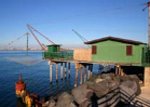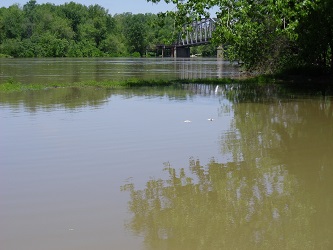Small Town Sprawl Is Costly Too
Last Updated: September 26, 2022
The disadvantage of small town sprawl is how costly it is to residents and the town government alike. Let's think of it this way. Let's say your town consists of 16 blocks. OK, we want this page to pertain to a small city also, so maybe it's 160 blocks. The idea is the same.
So let's go back to 16 because the math is simple. Your town could take the compact form of 4 blocks wide by 4 blocks long, right? Or it could be a sprawling 1 block wide by 16 blocks long. You might say, "Ridiculous." Well, we might be exaggerating just a bit, but not much.
Too often in our planning practice, we have seen that a "town" just stretches out as a continuous highway development fading too gradually into a ragged hodge-podge at the rural fringe.
So which town would be the nicest to walk in, the 4 X 4 shape or the 1 X 16 shape? Which one would require the least time to walk to the furthest destination in town? If you had to drive everywhere, which one would take you the least gas? The answer in all three cases is that the town that is 4 blocks wide and 4 blocks long would be more pleasant and functional.
If the town had to hire a garbage truck to drive everywhere, which one would use less gasoline? If you had to pay for new wiring or a new utility (cable TV was young not so long ago), which do you think would cost less to wire? If you wanted to allow children to roam free, which would make you feel more secure?

You want us to stop already because the answer is so obvious. But when it is our own town being described, sometimes we are used to the way things have always been, and we view any new construction as progress.
We might not be able to see that small town sprawl imposes costs of all types--social,
financial, and wasted time, energy, and materials.
One of the worst costs may be the types of businesses that are locating out on the highway. Sometimes those are national chains, farm stores, big box stores, and discount stores that take sales away from the family businesses in your downtown. One of the authors of this website watched as a downtown (in a college town, no less) was left with abundant vacancies when the big office supply store and the rural-oriented big box discount retailer chose locations on the highway headed out of town.
That's a social cost, because those downtown buildings will be problems to you when the family businesses give up and go out of business.
Plus those families probably are institutions in your community, and if they leave and retire to Florida, you've lost a philanthropic and civic booster, as well as a friend.
Now you're sending your profits to Los Angeles or somewhere instead of having the return on capital invested being spent in large part in your town.
What to Do About Small Town Sprawl
If you are losing that nice, clean edge between the town and the country, and if you're suffering from an elongated and unnatural shape due to highway development, this page is important to you.
Part of the charm of small towns is that they are readable; we know what to expect. We walk to the edge of town, and there is the delightful, unspoiled countryside. We can appreciate both the town and the country. But when they are intermingled, our brains and bodies don't respond quite as intuitively.
In small cities the principles are the same. And the larger the city, the more the financial inefficiencies of providing public services grow if small town sprawl is allowed to continue.
Below are the specific steps you should consider if you're facing this issue and you don't have and don't want any zoning.
1. Consider whether you can use municipal utilities to force a kind of growth boundary. If you've been extending your water line to anyone who asks, you're allowing unchecked small town sprawl. Don't do it. You could use your city limits as your utility district, or have the utility draw a line that is efficient considering the logistics of the particular utility. Craft a smart annexation policy to bring people who want your utilities into your community as voters and taxpayers.
2. You might be able to use some town-purchased open space to stop growth in a certain direction and channel it into a more compact form.
3. Run a social media campaign about the issue and the reasons that the small town sprawl is costly, and appeal to people's good nature. Maybe you can place petitions in small businesses in your downtown area for people to sign asking their neighbors not to expand small town sprawl in a particular direction.
Then make sure your most prominent and well-respected citizens sign first, before the petition even is posted. Present the petitions to your city in a public way, at a minimum as your city council meeting, or if your council already is somewhat sympathetic, maybe the downtown businesses could organize a little festival or event with live music where you make your presentation to the mayor.
4. Investigate your state laws on taxation to see if there's a particular tax you can impose right at the border of current development, and beyond.
It would be logical to form a special taxing district to collect money to build infrastructure (streets, utilities, and so forth), so maybe if you can't regulate them, you can tax them and thereby discourage further growth in a particular direction.
You might pair this with a tax break for building in the opposite direction, or building what is known as an infill housing or business use. "Infill" just means you’re filling in development on a vacant lot or area.
If you are ready to do some planning, explore what has to be done in your state to form a planning commission if you do not have one. If you want planning but not zoning, that can be accomplished in some states.
The planning but no zoning approach might result in the preparation of a long-range plan, ten-year plan, or whatever, and anything that is not in accordance with the long-range plan might require the approval of your town council in a procedure that includes public hearings and other barriers to quick action. Again, you'll have to find out what is legal in your state; you can read this for yourself onlline.
Another non-zoning approach is what is called the form-based code. These codes are usually much slimmer than zoning ordinances, and somewhat easier to administer.
However, an element of judgment is often required, so make sure that your town can handle it before investing the time and effort in a consultant preparing a form-based code to meet your needs.
In contrast to zoning, which concentrates on the idea of "land uses," meaning the activity that takes place mostly inside the building, the form-based code talks about the buildings themselves, how close to the street they should be, and generally how they should perform.
A form-based code could be tailored in most states to prohibit commercial buildings outside of what you might consider a reasonable boundary, and then show residential uses at a rural spacing outside of where you think your town should grow.
To investigate this latter approach, see the Form-Based Codes Institute website.
Your third option is to move toward zoning. It's a time-consuming process sometimes to first do a comprehensive plan, master plan, land use plan, or whatever the equivalent may be called in your area.
It's worthwhile, we think, and if you want to read about town planning in general, click the link and skip what seems too urban.
Also we include an overview of the zoning and theory of zoning.
You'll need a consultant or staff member with an education in planning if you want to go this route. Your town attorney also will need to become well acquainted with the theory of zoning and how due process of law pertains to zoning actions.
Overall, though, if you want to control small town sprawl, either a form-based code or zoning ordinance is probably your best bet in most situations. Don't make either more complex than is necessary to do the job.
Increasing your walkability is a great goal, particularly for the children and older adults. And certainly increasing your financial efficiency as a town government, and saving money for your citizens, could hardly be more noble as public policy goals.
So let's go after that small town sprawl while you're still a small town! Take action before you're presented with a crisis in the form of an undesirable huge business or big box store on the outskirts of town.
Check Out These Related Resources for Small Towns
- Making and Keeping a Good Community >
- Community Challenges, Common Topics & Concepts >
- Sprawl > Small Town Sprawl
Join GOOD COMMUNITY PLUS, which provides you monthly with short features or tips about timely topics for neighborhoods, towns and cities, community organizations, and rural or small town environments. Unsubscribe any time. Give it a try.




